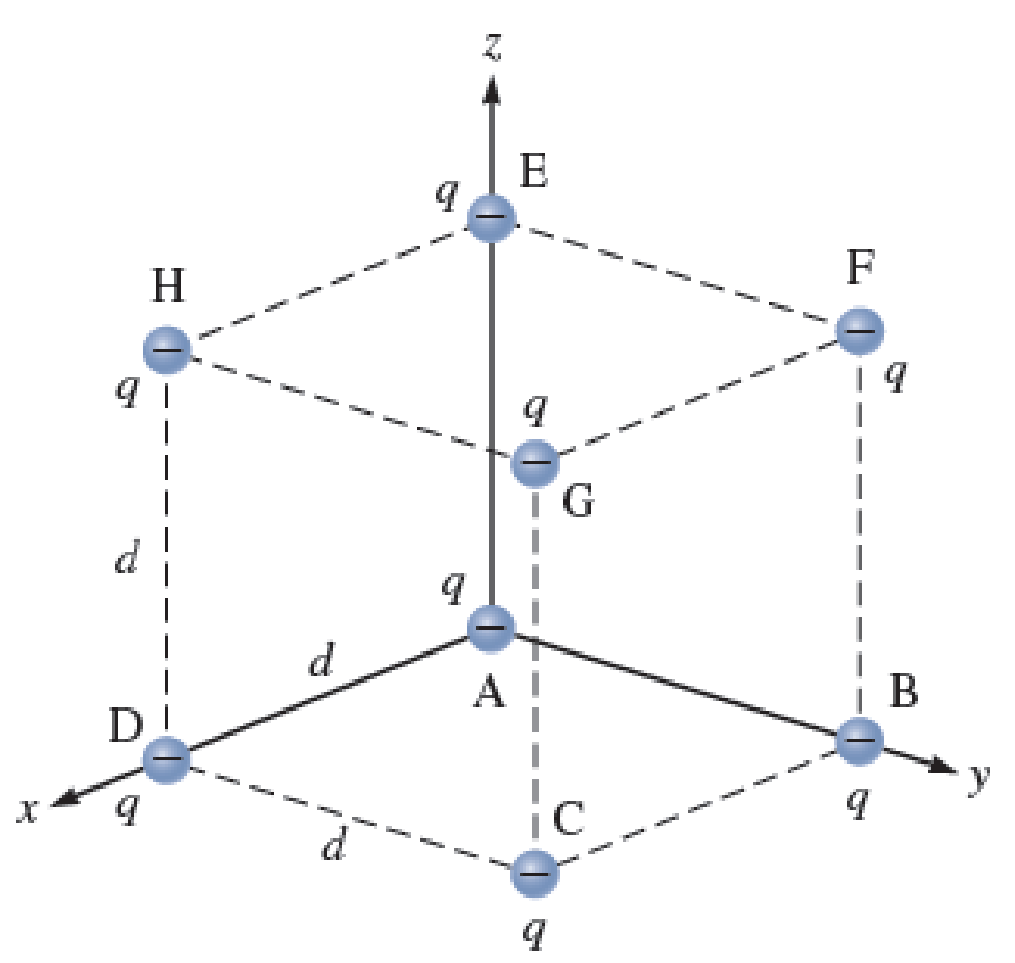
Concept explainers
Eight small

Figure P23.75
The total force on the sphere A due to seven spheres.
Answer to Problem 75PQ
The total force on the sphere A due to seven spheres is
Explanation of Solution
Write the expression for Coulomb’s law.
Here,
The forces produced by other spheres on A.
| Charge | force |
| B | |
| C | |
| D | |
| E | |
| F | |
| G | |
| H |
Write the expression to find the total force on the sphere A due to seven spheres.
Here,
Substitute
Conclusion:
Substitute
Therefore, the total force on the sphere A due to seven spheres is
Want to see more full solutions like this?
Chapter 23 Solutions
Physics for Scientists and Engineers: Foundations and Connections
- Look at the answer and please show all work step by steparrow_forward3. As a woman, who's eyes are h = 1.5 m above the ground, looks down the road sees a tree with height H = 9.0 m. Below the tree is what appears to be a reflection of the tree. The observation of this apparent reflection gives the illusion of water on the roadway. This effect is commonly called a mirage. Use the results of questions 1 and 2 and the principle of ray reversibility to analyze the diagram below. Assume that light leaving the top of the tree bends toward the horizontal until it just grazes ground level. After that, the ray bends upward eventually reaching the woman's eyes. The woman interprets this incoming light as if it came from an image of the tree. Determine the size, H', of the image. (Answer 8.8 m) please show all work step by steparrow_forwardNo chatgpt pls will upvotearrow_forward
- Please solvearrow_forwardPlease solvearrow_forwardA piece of silicon semiconductor has length L=0.01cm and cross-section in a square shape with an area of A=5×10−4cm2 . The semiconductor is doped with 1012cm−3 Phosphorus atoms and 1017cm−3 Boron atoms. An external electric field E=1.5×104N/C is applied to the silicon piece along the length direction, through the cross section. What is the total current in the silicon at T=300K? Assume the mobility of silicon is 1400cm2V−1s−1 for electrons and 450cm2V−1s−1 for holes, respectively. Assume the intrinsic carrier concentration in silicon is 1010cm−3 . Give your answer in mA, rounded to 3 significant figures. Just enter the number, nothing else.arrow_forward
- An impurity with a charge of 2e is placed in a three-dimensional metal. Assume that the Friedel sum rule holds for this system, and only the scattering phase shifts from the electrons contribute to this sum (we don't need to consider ion phase shifts). This metal has a spherical Fermi surface with Fermi wave vector kF . The only degeneracy for the electrons at the Fermi surface is spin (two-fold) and angular momentum ( 2l+1 for each angular momentum l ). Ignore scattering for l>2 and assume that the scattering doesn't depend on the spin degree of freedom. Denote the scattering phase shift at the Fermi wave vector in the l -th angular momentum channel as δl(kF) . If δ0(kF)=11π31 , and δ1(kF)=π29 , what is δ2(kF)? Round your answer to three significant figures. Just enter the number, nothing else.arrow_forwardA pilot with a mass of 75 kg is flying an airplane at a true airspeed of 55m/s in air that is still relative to the ground. The pilot enters a coordinated turn of constant bank angle and constant altitude, and the pilot experiences an effective weight of 1471.5N normal to the wings of the plane. What is the rate of turn (in degrees per second) for the aircraft? Round your answer to three significant figures. Just enter the number, nothing else.arrow_forwardImagine you are out for a stroll on a sunny day when you encounter a lake. Unpolarized light from the sun is reflected off the lake into your eyes. However, you notice when you put on your vertically polarized sunglasses, the light reflected off the lake no longer reaches your eyes. What is the angle between the unpolarized light and the surface of the water, in degrees, measured from the horizontal? You may assume the index of refraction of air is nair=1 and the index of refraction of water is nwater=1.33 . Round your answer to three significant figures. Just enter the number, nothing else.arrow_forward
 Physics for Scientists and Engineers: Foundations...PhysicsISBN:9781133939146Author:Katz, Debora M.Publisher:Cengage Learning
Physics for Scientists and Engineers: Foundations...PhysicsISBN:9781133939146Author:Katz, Debora M.Publisher:Cengage Learning Principles of Physics: A Calculus-Based TextPhysicsISBN:9781133104261Author:Raymond A. Serway, John W. JewettPublisher:Cengage Learning
Principles of Physics: A Calculus-Based TextPhysicsISBN:9781133104261Author:Raymond A. Serway, John W. JewettPublisher:Cengage Learning Physics for Scientists and EngineersPhysicsISBN:9781337553278Author:Raymond A. Serway, John W. JewettPublisher:Cengage Learning
Physics for Scientists and EngineersPhysicsISBN:9781337553278Author:Raymond A. Serway, John W. JewettPublisher:Cengage Learning Physics for Scientists and Engineers with Modern ...PhysicsISBN:9781337553292Author:Raymond A. Serway, John W. JewettPublisher:Cengage Learning
Physics for Scientists and Engineers with Modern ...PhysicsISBN:9781337553292Author:Raymond A. Serway, John W. JewettPublisher:Cengage Learning College PhysicsPhysicsISBN:9781285737027Author:Raymond A. Serway, Chris VuillePublisher:Cengage Learning
College PhysicsPhysicsISBN:9781285737027Author:Raymond A. Serway, Chris VuillePublisher:Cengage Learning College PhysicsPhysicsISBN:9781305952300Author:Raymond A. Serway, Chris VuillePublisher:Cengage Learning
College PhysicsPhysicsISBN:9781305952300Author:Raymond A. Serway, Chris VuillePublisher:Cengage Learning





